► Life with a BMW 730d M Sport
► A trad limo crammed with tech
► Details on economy and more
Month 7 running a BMW 7-series: final report
For the 26th and final time I find myself on the forecourt pumping diesel into our BMW 7-series, and trying to figure out if this is an emotional goodbye. There’s no actual tear in my eye (except when confronted with the £101.55 bill for the gas), but I admit the car has made more than a hanging chad impression on me. A conundrum, however, it remains.
BMW can do big saloons with its eyes shut, but its eyes are never shut. Every corporate, engineering, technology and design sinew is strained to full tolerance each time it brings a new 7-series to market. The previous car, the fifth generation, whose lifespan virtually mirrored that of Cameron’s coalition government, was immense. ‘If this is a limo I want to retrain as a chauffeur, because it’s absolutely epic to drive,’ I wrote, when saying goodbye to our long-term 09-plate F01 730d in the May 2010 issue of CAR. Six years later the same can be said again, word-for-word, of this 65-plate G11 generation. As far as the ultimate driving machine is concerned, there has been no mission creep.
Much has been made of the current 7’s array of edgy technology, and I’ve done my best to be impressed, but quite a lot of the really excellent stuff – active roll stabilisation, night vision, head-up display, active steering – was already on the previous car. And, with apologies to geekdom, quite a lot of the new stuff is window dressing. Gesture control is not ready yet, the smart key doesn’t really add anything, the removable tablet is rather gimmicky, and self-parking (not fitted on my car, but we tried it out) is clever but wouldn’t work in any UK car park I’ve ever been to because it can only move forward or back in a straight line. And while none of this criticism amounts to condemnation, everywhere you look there’s obsolescence lurking.
It’s the stuff you can’t see that cuts through, that proves the evolution of the species. The radical use of carbon core technology cuts weight (130kg compared with our old car) and establishes phenomenal body control, the intuitive eight-speed auto ’box is a giant leap, the anti-roll bars are now electromechanically operated, and the 3.0-litre twin-turbodiesel is way torquier than before (457lb ft against 395) yet substantially cleaner and so much more efficient you’ll do a double-take. Previously 37.2mpg, now 60.1? Astonishing. At this rate of progress the 2026 730d will top 100mpg (on paper, obviously – we actually averaged 39.8).
The bigger question is this: is there a place for a massive, premium three-box saloon in 2016, beyond its traditional purposes of VIP-shuffler, tech showcaser and halo-adorned range-topper? In an age of astonishingly capacious SUVs and family swallowing MPVs a car of this size (at 5098mm it’s longer than a Range Rover) that seats only four, and with the rear two in disappointingly cramped conditions in the standard wheelbase version, seems off the pace, despite the beautifully appointed cabin and epic seats.
Then there’s the dreary reality: what will this car be worth in five years’ time? Our previous 730d was priced at £56,790 (£75,015 once we’d over-specced it), yet today we found an almost identical spec car for around £14,000 with 100k miles. And despite the car’s rarity – UK sales can be counted in hundreds – there are plenty out there. This year’s model is priced at £68,180 (£84,465 as tested). At 12k miles and a year old it’s already shed £25,000. What will it cost in 2020? £15,000? That’s not only a plummetous hit, it’s also a lot for a car packed with technology that’s long been left for dead. On the other hand, clinchingly, it’s peanuts for a fabulous driver’s car.
And I want to leave no doubt in any reader’s mind here: the 7 is a fabulous driver’s car. All the cautions and caveats mentioned above are made in the name of due care, fashioned to satisfy the latest EU directive mandating sensibleness every time excess is mentioned. But hell, we’ve quit the EU, so their rules can’t touch me now. I would buy a 7-series today if I could afford it, no question. And if I can get one in 2020 for £15k, well, there’s no decision to make.
Count the cost
Cost new £84,465 (including £16,285 of options)
Dealer sale price £62,683
Private sale price £58,283
Part-ex price £54,368
Cost per mile 10p
Cost per mile including depreciation £2.59
Logbook: BMW 730d M Sport
Engine 2993cc 24v inline six, 261bhp @ 4000rpm, 457lb ft @ 2000-2500rpm
Gearbox 8-speed auto, rear-wheel drive
Stats 6.1sec 0-62mph, 155mph, 129g/km CO2
Price £68,180
As tested £84,465
Miles this month 1515
Total miles 12,121
Our mpg 39.8
Official mpg 60.1
Fuel cost overall £1226.01
Extra costs £0
By Greg Fountain
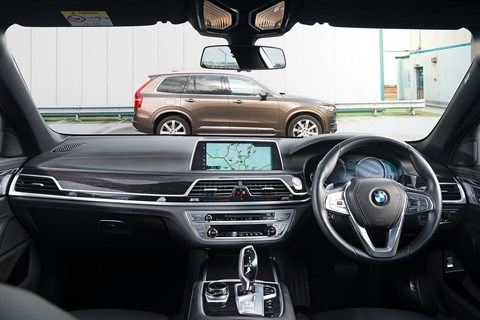
Month 6 running a BMW 7-series: dust-up at the premium club
At the swanky end of our fleet are two ideas of luxury. Has lux SUV usurped lux saloon? We argue it. By Greg Fountain & Tim Pollard.
GF: Let’s be absolutely clear about this, Tim, it’s all your fault. If you hadn’t lavished £16,440 on extras, thereby inflating your Volvo’s £50,185 pricetag to within a Samantha Cameron Micra’s distance of my my BMW then we wouldn’t be having this conversation. But at £66,625 vs £68,180 it’s just too tempting to resist the idea of asking a zeitgeisty question: is the SUV actually the new premium saloon? And before we go any further, don’t let me hear any of this nonsense about how I spent almost the same on extras (£16,285) as Tim did. Mine were all essentials like night vision and seat ventilation. So, Tim, in 2016 whose car is the real luxury deal?
TP: You’re right to compare these two, Greg. Buyers gave up picking cars by traditional shape or segment years ago. Okay, so I can’t imagine many families of five or six choosing a 7-series as their primary transport (it’s risibly cramped in the back seats in SWB form, isn’t it?) but I can imagine business user choosers hovering over the Volvo tickbox on the company car wishlist. Eddie Exec wouldn’t be disappointed, either – the XC90’s a fine place to sit, with a modern Scando-luxury vibe percolating its fabulously appointed cabin. This pair make a fascinating case study of modern luxury. Yours is all German techno clever-clogs, the Volvo a more chilled-out kind of Swedish modernism.
GF: No kidding about the BMW’s rear seats. The measly space is incredibly disappointing, and legroom for the front passenger isn’t amazing either. Never thought I’d say the words ‘get the stretched version’, but get the stretched version. The Volvo is a people-packaging masterclass. It’s 148mm shorter than the BMW overall, yet into its 86mm shorter wheelbase it achieves three rows of seating, two of which upgrade BMW’s Ryanair kneeroom to Business Class. The seats in both cars are quite lovely though – both multi-adjustable, supportive, and leather-bound (though my black nappa is more practical than Tim’s ‘blond’, which is now more like ‘denim’). And I get eight types of massage thrown in.
TP: Agreed, the Volvo’s cabin has lashings of Scando chic. But it’s the XC’s lofty driving position which really differentiates these two. It’s bang on crossover trend, albeit with a hefty weight/height/bulk penalty…
GF: …a driving position no chauffeur would entertain. But if it feels a bit van-like, the pay-off is the freight capacity of said van, plus the ability to ford streams or escape summer festival car park mud. The 7 struggles even to get off my drive on an icy morning. I can play with my gadgets while waiting for a tow, though.

TP: Maybe, but although I love the BM’s massage seats, some of the other tech onboard the 7-series – and there is plenty – strays into why-bother territory. Gesture control is fun to show the kids, but you can also use steering wheel buttons and a physical volume control to change the stereo. Is this progress? Feels like it’s stepping-stone technology v1.0, that’ll soon replace all switchgear in tomorrow’s BMWs…
GF: Yes, the eye-catching technologies – including the digital ‘smart key’ – are not the most stirring bits of 7-series cleverness (particularly as the smart key’s remote-control parking function isn’t fitted and the pre-heating function appears not to work). For me it’s the structural and dynamic stuff – active chassis control, air suspension, elctromechanical anti-roll bars, part-carbon construction, laser lights – that enthrall. The XC90’s dynamics are skewed heavily towards lugubrious wafting, which it does well, but only thanks to the £2150 addition of air suspension. Without it the 7 not only has tighter body control but also rides better.
TP: Ouch! But, actually, I agree. The BMW shrinks around you and has one of the most varied adaptive chassis you’ll find anywhere: put it in Comfort+ and you’ll hyper-waft like a Citroën DS on diazepam; flick to Sport and it’s corner-carving like a ’Ring raver. Impressive. Mind you, it can’t lug a fridge home from John Lewis or take my family and the kids’ friends to a rugby match in comfort. The XC90 is indisputably the more rounded car, even if it can’t do an impersonation of a super-sized M3.
GF: At which point I reveal that I actually agree with you. I love the 730d with a passion, and its punchy six-pot turbodiesel makes the XC90’s over-downsized four-pot seem like a sewing machine motor on a two-tonne car, but I’d buy the Volvo, I really would. It’s chasmically proportioned, built like a granite safety net, will get me through the winter, and that lovely big-screen, iPad-alike interface is better resolved even than iDrive. You say it’s more rounded, Tim? You’re right.
TP: Go on then. Sum up my car in a tweet. Your gadget-laden Seven’s hashtag is surely #RTFM. Although the iDrive’s voice recognition might not approve of such language…
GF: Spacious living area, Swedish furniture, easy living #damnyouVolvo!
Logbook: BMW 730d M Sport
Engine 2993cc 24v inline-six, 261bhp @ 4000rpm, 457lb ft @ 2000-2500rpm
Transmission 8-speed auto, rear-wheel drive
Stats 6.1sec 0-62mph, 155mph, 129g/km CO2
Price £68,180
As tested £84,465
Miles this month 1128
Total miles 10,606
Our mpg 39.9
Official mpg 60.1
Fuel cost £133.08
Extra costs £0
Logbook: Volvo XC90 D5 AWD Inscription
Engine 1969cc 16v 4cyl turbodiesel, 222bhp @ 4250rpm, 361lb ft @ 1750-2500rpm
Transmission 8-speed automatic, all-wheel drive
Stats 7.4sec 0-60mph, 137mph, 152g/km CO2
Price £50,185
As tested £66,625
Miles this month 1200
Total 4610
Our mpg 29.1
Official mpg 48.7
Fuel this month £194.75
Extra costs £0
Read more about our long-term Volvo XC90 here
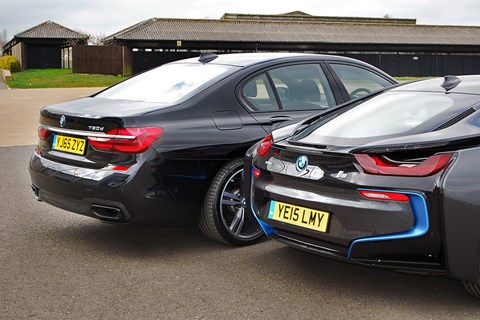
Month 5 running a BMW 7-series: old, or new?
Park the 730d next to an i8 and something odd happens to the space/time continuum. And what’s interesting is that rather than the i8 looking futuristic, the Seven merely looks old. Also, the i8 does rather look as if someone’s sat on it.
Do they compare? You decide. 730d: four conventional doors, six-pot diesel, 0-62 in 6.1sec, 129g/km CO2, £68k; i8: two scissor doors, three-pot petrol with 96kW motor, 4.4sec, 49g/km, £104k. Both have four seats (both are tight in the back) and both use carbonfibre and aluminium. So, in 2016, which is BMW’s halo car?
Logbook: BMW 730d M Sport
Engine 2993cc 24v inline six, 261bhp @ 4000rpm, 457lb ft @ 2000-2500rpm
Transmission 8-spd auto, rwd
Stats 6.1sec 0-62mph, 155mph, 129g/km CO2
Price £68,180
As tested £84,465
Miles this month 1481
Total 9478
Our mpg 40.5
Official mpg 60.1
Fuel £188.28
Extra costs £0
By Greg Fountain
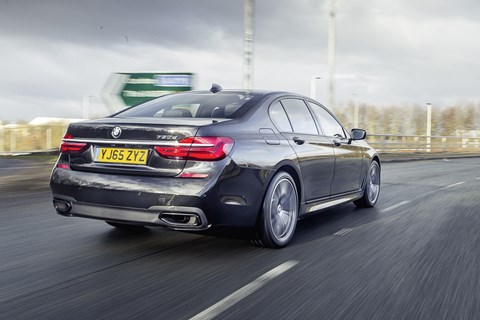
Month 4 running a BMW 7-series: ultimately, still a driving machine
You’d swear it was a smaller car. Hard to credit, when you fling it ill-advisedly at a tightening corner, that the back wheels currently defying physics in applying 457lb ft of torque to the road are so far away. This 7-series feels like you’ve got it in your pocket, like it’s part of you.
There’s none of the S-class’s squat or dive, none of the A8’s waft or wallow, just a clinical approach to the business of ground-covering without drama. Stick the adaptive suspension in Sport and the car drops by 10mm on its self-levelling air suspension, beginning a conjuring trick that encourages fast but imprecise locomotion through corners without either understeer or breakaway (you wouldn’t want the latter – despite weight-saving carbon core technology it’s still 1755kg of momentum). And all this while maintaining, via variable damper control and electromechanical roll stabilisation, your rear-seat passenger’s focus on the FT.
This isn’t a road test, but I did ask you a couple of months back to remind me to tell you what the 7-series is like to drive (it’s easy to get bogged down in tech, after all). And from under the chauffeur’s hat it does feel special. The throttle is so sweet I expect it to bring me an apple at the end of term. Modulating it is like dancing with Darcy Bussell, a masterclass in effortless weight shifting and tremendous sweep, and its relationship with the well-judged electric steering is for life. It’s a confidence thing. Only Porsche gets close to such perfectly synergised control systems.
Said synergy enters some kind of alternate dimension when you press the Adaptive button, to access a part of BMW’s brain which (scarily) learns your driving style, adds the data to intel gleaned via onboard cameras and sat-nav, and constantly tinkers the chassis, suspension and dampers to tailor refinement. It’s a bit like Merc’s Magic Ride control, in that I have no idea how/if it works, but the ride is like the Eurostar on the French side, if marginally less compliant than the S-class.

You hardly notice the work of the eight-speed auto ’box, but it’s sympathetic to the whims of the 3.0-litre turbodiesel, which in itself is thrustier than its vital stats suggest. It all hooks up beautifully. What’s really clever is that, for all the digital trickery and chip-fed boffinry on board, BMW has remained loyal to the ultimate driving machine ethos, leaving you with three out of five senses fully entertained (it doesn’t taste or smell that special). Analogue satisfaction in a digital age. I’ll take that.
But if this isn’t a road test it also isn’t a brochure, and demerits exist. Here’s the juiciest: twice, when reversing confidently into a space, the car has suddenly slammed on the anchors, sending all occupants into shock and spilling coffee. The common denominator seems to be that in both cases (one in a multi-storey, one in my driveway) I passed close to a post. The sensors, perhaps, decided I was about to hit something (which I wasn’t). This is more embarrassing than Britain’s Got Talent (which it hasn’t).
From the driving seat
+ Large car with the dynamic integrity of a small coupe
– Not so large as to provide adequate rear legroom
+ More tech than you could shake a stick at
– But the stick in question is a virtual digital i-stick so you don’t get to shake it yourself
Logbook: BMW 730d M Sport
Engine 2993cc 24v inline six, 261bhp @ 4000rpm, 457lb ft @ 2000-2500rpm
Transmission 8-speed auto, rear-wheel drive
Stats 6.1sec 0-62mph, 155mph, 129g/km CO2
Price £68,180
As tested £84,465
Miles this month 971
Total miles 8968
Our mpg 40.4
Official mpg 60.1
Fuel cost £125.21
Extra costs £0
By Greg Fountain
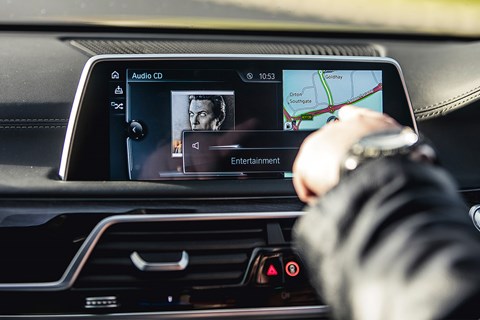
Month 3 running a BMW 7-series: an unnecessary plethora of options
The result is in earlier than expected: gesture control doesn’t work, not even if you’re ET. At least, not yet. BMW knows this, of course – that’s why the 730d offers three other ways of turning the radio down – but I applaud the fact they’ve put the technology out there, ready or not.
Trouble is, there’s so much tech in the 7-series I can’t decide what to use. Tap the screen? Turn the iDrive dial? Use the dial-top touchpad? Try voice control? Use the wheel-mounted controller? Turn the analogue knob? BMW is better qualified than me to decide, yet obviously can’t make up its mind either.
By Greg Fountain
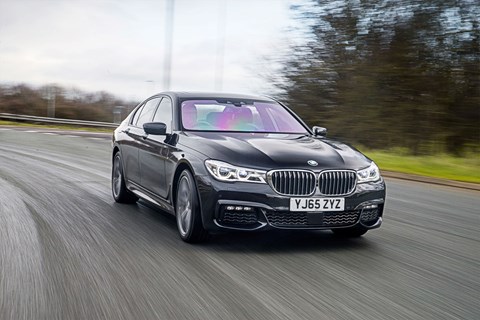
Month 2 running a BMW 730d: seats and questionable packaging
Being in the driving seat is simply delicious, but difficult information is filtering through from occupants of the other three chairs. This is a big saloon, right – an almost limo? So how come my 5ft 4in wife struggles for knee room in the front? And why do those behind mention (you could not call it complaining) that they’re packed in rather tight?
It’s a bit of a shock to discover when piloting ‘the largest series-production BMW ever’ (it’s 5098mm long) that I’ll need the long-wheelbase model with extra 14cm of wheelbase to truly don that chauffeur’s cap. ‘Send me the head of packaging, Miss Snibbs!’
By Greg Fountain
Month 1 running a BMW 7-series: meet our 730d
Radical futurism and defiant traditionalism are surely opposing philosophical schools, but which does the new BMW
7-series subscribe to? A conventional three-box saloon, it swaggers into the SUV party like Antonio Fargas at the GQ awards, wildly out of fashion but holding the room on sheer force of personality.
But in its pocket the 7-series carries an array of technology so staggering it not only shames many would-be trendsetting rivals, it also threatens to shade the mantra on which Munich built its reputation: ultimate driving machine. With that in mind please, at some point over the coming months, do remind me to talk about what it’s like to drive.
Meantime, let’s look at what we have. This is the 730d with M Sport trimmings, which is number three in the 14-strong UK model range, with a base price of £68,180, which includes the slightly twinkly ‘Black Sapphire’ paint and black Nappa leather massage chairs. That’s a bullish tag for this much car, but once we’d been left alone with the options list for a few moments we ended up poorer to the tune of £84,465.

Blame technology – we coughed £2466 on Driving Assistant Plus (lane departure warning, speed limit recognition, active cruise, stop/go, steering assist), two grand on laser lights, another two on Executive Drive Pro (active chassis control – we’ll get to that) and £1500 on Night Vision (spots pedestrians and animals in the dark). Spending another thousand on something as old-school as wheels – 20in double-spoke alloys – seemed almost dirty in comparison.
Speaking of dirty, here is the oily news: under the pool-table-sized bonnet there’s a 3.0-litre inline six-cylinder twin-turbodiesel which makes up for in torque (457lb ft) what it certainly lacks in power (261bhp). It drives the rear wheels (sounds obvious, but you can get the Seven in xDrive spec too) via an eight-speed ‘Steptronic Sport’ ’box, allied to hardly needed shift paddles and a not-needed-at-all launch-control function.
If you’re thinking the engine seems modest for such a big, heavy car, consider this: the 730d ain’t heavy. It’s 130kg lighter than before (now at 1755kg), thanks to the purloining of construction methods from the ‘i’ project – so-called ‘carbon core’ technology. The Seven uses carbonfibre-reinforced polymer bonded to a structure made of both steel and aluminium – the latter accounting for the doors, bootlid, and much of the suspension, which in turn does wonders for ride quality.
Refinement, in fact, is what limo buyers crave most of all, and here’s where this BMW really grabs you by the lapels. Kudos to the aforementioned Executive Drive Pro, which embellishes BMW’s variable dampers and the Seven’s air suspension with electromechanical anti-roll bars, resulting in simply fabulous ride quality. You can select your preferred setting – Comfort Plus is up there with cousin Rolls-Royce – but in Adaptive mode the car takes readings from your driving style, the onboard cameras and the sat-nav to constantly tweak the settings. ‘Quite clever’ in the same way Attila the Hun was ‘quite naughty’.
Of course, the tech headlines are never grabbed by oily or structural matters. No pub-visiting 730d owner will open with electromechanical roll stabilisation – he’ll always start with gesture control. This nascent marvel allows you to control functions on BMW’s first ever touchscreen without, ironically, touching it. Waft a finger or two in the desired pattern and a 3D sensor in the rear-view mirror assembly recognises it and acts on it, turning the volume down, for instance, or rejecting an incoming call. So far it’s proving temperamental; the analogue volume knob taunts me!
Our pub bloke will next mention the removable Samsung tablet located in the rear armrest – which can control the car’s systems as well as controlling your stock portfolio and Angry Birds portfolio – and he’ll seal his mates’ amazement by whipping out the smart key, which is basically a mobile phone that doesn’t make calls, but which can park the car for you or switch the heater on five minutes before you leave the house.
There’s so much to talk about – knowing where to start is the hardest part. No mention of that in the manual.
By Greg Fountain
